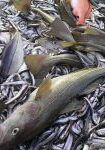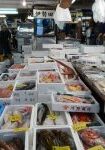FSBI Briefing Papers
Prepared by experts in a form accessible to both specialists and non-specialists, including the general public, the papers present detailed, authoritative peer-reviewed syntheses of current knowledge on selected topics of wider public interest relevant to the Society’s objectives.
The Briefing Papers, which provide syntheses of current knowledge, have attracted considerable interest and the FSBI has found them to be an effective means of promoting scientifically-informed public discussion about important and controversial topics in fish biology and fisheries science.
What does a Briefing Paper Consist of?
The FSBI offers funding of up to £5000 to help support the development of the Briefing Papers
The FSBI Council welcomes suggestions from its membership and will provide some funding to help support the process.
All FSBI members are eligible to apply for financial support from this scheme. This funding may be used to bring potential authors together in a workshop to discuss the ideas and content of a Briefing Paper, to provide some technical support, to cover costs for access to papers, or any other costs that will promote the development of the Briefing Paper.
Briefing Papers submitted as a Review to the Journal of Fish Biology are subjected to the full peer-review process required of all JFB submissions, but if accepted for publication, they will be made Open Access without charge to the authors. Such papers tend to accrue a high citation rate.
If there is a topic that you feel is appropriate for a Briefing Paper then please contact the FSBI Administrator with the following information:
1) a title
2) a brief statement on why this topic is appropriate as a Briefing Paper (including the main issues involved and where the public interest lies)
3) a suggested author or group of authors.
Contact the Administrator Here
AND
Published Briefing Papers

Impacts of Anthropogenic Noise on Fishes
There is growing international concern about the potential effects of anthropogenic (human-made) noise on fishes in our seas, lakes and rivers. Human noise-generating activities are increasing. These activities include shipping, sonars, offshore oil and gas exploration and production, dredging, trawling, and other industrial activities, including the construction of renewable energy systems. Continuous sounds from activities like shipping increase overall background noise levels, whereas others, including construction work, produce shorter but more intense sounds. Many of these sounds have the potential to affect fish behaviour, whereas the most intense sounds may cause physical harm to animals near the source. In order to regulate sound-producing activities, there is an urgent need to establish sound exposure criteria. Future research must focus on providing information that will lead to improvement of the quality and validity of regulatory guidelines and criteria.
Download pdf: Downloadable Version

Effects of fishing on biodiversity in the North Sea
Biological diversity means the variability among living organisms from all sources including, inter alia, terrestrial, marine and other aquatic ecosystems and the ecological complexes of which they are part; this includes diversity within species, between species and of ecosystems. Any shift in diversity, positive or negative, as a result of fishing disturbance is cause for concern. Here we review current understanding of the impact of fishing on genetic and species diversity within the confines of the North Sea, which is one of the world's major shelf areas boasting a productive ecosystem and a substantial fishery exploited by eight bordering European countries.
Download pdf: With references | Without references

Fish Welfare
Those who work professionally with fishes, whose sports or hobbies involve fish and those concerned with the welfare of animals in general seek answers to a number of questions about the effects of human activities on fish welfare. This Briefing Paper considers how welfare is defined and measured, and examines how various human activities affect fish welfare. No opinion is given about what is acceptable and what is unacceptable, but based on current knowledge harmful effects are identified so that others can make their own informed judgements.
Download pdf: With references | Without references

Marine Protected Areas in the North Sea
The concept of using Marine Protected Areas (MPAs) to conserve fisheries and the marine environment generally has come largely from sedentary fish living on tropical reefs. MPA objectives include stock maintenance or recovery, habitat restoration, protection of non-target species, development of recreational and educational activities, and promotion of scientific understanding. However, the environment and resources of the North Sea are quite different from those from which the MPA concept has been primarily derived, and therefore the application of MPAs in areas such as Northwest Europe needs careful consideration. The MPA concept has had a mixed reception from the scientific community, and this Briefing Paper discusses the extent to which MPAs conserve and protect fish stock and habitat whilst serving industry and other concerns.
Download pdf: With references | Without references

Effects of Climate Change
Environmental change is a characteristic feature of life on earth, and has played a major role in the evolution and global distribution of biodiversity. However, the predicted rate of climatic change, especially in temperature, is such that it will exceed any that has occurred over recent geological time. There is a wide scientific consensus that human activities have modified the composition of the atmosphere, and that this will result in significant future climatic change (e.g. increased air temperature in the UK of 2.0-3.5°C over the next 80 years), with consequences for biodiversity as well as ecosystem structure and function. To understand why climate change has important consequences for the fishes of Britain and Ireland, this Briefing Paper examines how the climate of Britain and Ireland has changed in recent decades and the consequences of future climate predictions (using the UKCIP02 United Kingdom Climate Impacts Programme report) for aquatic ecosystems, with specific reference to freshwater, marine and brackish water fish communities.
Download pdf:With references | Without references

Non-native freshwater fish introductions
The rate at which non-native freshwater fishes have been introduced worldwide has doubled in the space of 30 years, with the principal motives being aquaculture (39%) and improvement of wild stocks (17%). Economic activity is the principal driver of human-mediated non-native fish introductions, including the globalisation of fish culture, whereby the production of the African cichlid tilapia is seven times higher in Asia than in most areas of Africa, and Chile is responsible for around 30% of the world's farmed salmon, both based on introduced species. The review is a contemporary account of knowledge on aspects of introductions of non-native fish species and includes issues associated with introduction pathways, ecological and economic impacts, risk assessments, management options and impact of climate change. It offers guidance to reconcile the increasing demands of certain stakeholders to diversify their activities using non-native fishes with the long-term sustainability of native aquatic biodiversity.
Download pdf: With references | Without references

Nanotechnology in fisheries and aquaculture
Nanotechnology is the application of nano scale materials to products or processes which has become a rapidly growing industry now worth billions of US dollars, with many potential benefits to society, including fisheries and the aquaculture industry. Applications for fisheries could include nano polymers and coatings to strengthen food packaging to protect delicate fish fillets. The shelf life of fish and shellfish could also be improved through the use of anti-bacterial nano coatings, and transparent polymer films that could help exclude oxygen from the food product. Nano sensors could also be used on food packaging. Fish will eat feed containing nanomaterials (NMs) and nanotechnology could be used to improve infeed delivery of micronutrients, or unstable ingredients, such as fat soluble vitamins, minerals, or fatty acids. Fish health applications in aquaculture could include antibacterial surfaces in aquaculture systems delivery of veterinary products, and nanosensors for detecting aquatic pathogens. There are also many applications for nanotechnology in water purification. From an engineering perspective, there is an abundance of new building materials, textiles, and fabrics that could be used in aquaculture engineering and on fishing vessels. Occupational health risks from NMs are probably low for fisheries workers given that few staff would be exposed to raw NMs or free particles, but guidance is already available for safe handling. Current ecotoxicity data suggest that manufactured NMs have relatively low toxicity compared to some traditional chemicals, but there are many data gaps, including those for important aquaculture and fisheries species. The benefits of using nanotechnology in fisheries and aquaculture are considerable, the potential data gaps on hazards to the environment or health are manageable, and should not stifle responsible innovation.
Download pdf: With references
